Poisonous porcini mushroom. Poisonous mushrooms: is the satanic mushroom edible or not, why is it so named
satanic mushroom(Boletus satanas) belongs to the Boletov family, the Boletus genus, it can also be called a devil's mushroom, poisonous (some sources indicate that it is conditionally edible).
- Differs in large sizes. The hat has a hemispherical shape, dry and velvety to the touch, 10 to 25 cm in diameter. The color of the hat is whitish, dirty grayish, with olive or yellow tint. May have stains of pale green, yellow-pink.
- On the inside, the cap is spongy. At young mushroom tubules yellowish, later greenish-yellow. The pores are small, at first yellowish, with age they become orange, red, red-brown, when pressed they turn blue- green color.
- The flesh is pleasant in appearance, white or creamy, and reddish in the leg area. On the cut, it slowly changes color, first turns red, then turns blue within a few minutes.
- The structure of the stem is characteristic of the classic boletus: massive, barrel-shaped, tapering towards the cap. Its height can reach from 6 to 15 cm, and its thickness is from 3 to 10 cm. The color in the upper part of the leg, closer to the cap, and at the base, is yellowish, in the middle part it is red or orange-red with a mesh pattern.
The debate about whether the satanic mushroom is edible or not continues to this day. In its raw form, even a small piece causes serious harm to the body. But at the same time, the toxin contained in the pulp decomposes under the influence of temperature. On this basis, some experts classify the imp as conditionally edible. True, to neutralize the toxin, you must first soak and then cook the "harvest" for 10 hours. And to say for sure what percentage of toxicity remained after processing, it is possible only after laboratory analysis(so it's better not to risk it).
Places of distribution

The devil's mushroom is quite rare in our forests - it prefers a warmer climate. Feels more comfortable on calcareous soils. The period of active fruiting is summer and early autumn, singly or in groups.
It lives in deciduous forests, likes to settle next to oaks, chestnuts, lindens. Can be found in beech or hornbeam forests (south of Europe, Russia, Middle East).
How to distinguish from similar species?
Exists whole line painful, having a similar appearance. Among them: whitish boletus, pink-skinned boletus (poisonous when raw), false satanic mushroom and others. All of them are inedible.
There are also many twins among edible and conditionally edible: porcini(true boletus), dubovik. The white mushroom differs from the devil one in that its flesh does not turn blue on the cut, in young specimens the color of the tubular layer is white or cream, in old specimens it is greenish.
It's more difficult with . The latter has a slightly darker hat, a more pronounced olive tint, but outwardly it is not always possible to distinguish it from a satanic mushroom. Therefore, you have to look at the behavior of the cut of the pulp. In the olive-brown oak tree, it immediately turns blue, and in the poisonous double, it slowly changes color, first to red, and then turns blue.
Signs of poisoning and first aid
The primary signs of poisoning are classic:
- nausea;
- weakness;
- dizziness;
- confusion;
- cutting pain in the abdomen;
- diarrhea.
Then activity is disrupted of cardio-vascular system: pulse quickens, blood pressure decreases. Symptoms of dehydration appear. If help for poisoning with a satanic mushroom is not provided immediately, dehydration is aggravated, the functioning of the liver and kidneys is disrupted. Possible respiratory arrest, paralysis nervous system.
A set of measures to provide assistance includes gastric lavage, intake of adsorbents: soda solution orally or activated charcoal. After that, you need to immediately go to the hospital.
Many biologists define the satanic mushroom as conditionally edible, but they do not dare to try it. This representative of the mushroom kingdom is quite insidious: even after correct processing it is difficult to determine whether all toxins have been neutralized. Therefore, you should not risk your health: if you come across a mushroom similar to this one, throw it away.
Mycologists classify the satanic mushroom as conditionally inedible. By and large, thermally, of course, you can rid it of harmful substances, but nothing can cope with the bitter taste. Therefore, it is almost impossible to eat it. Most likely because of these palatability mushroom pickers and endowed the "forest devil" with this name. Indeed, in ancient times, mushrooms were gathered “to taste”, everything was tried right on the spot and in its raw form. And the double, who arranged such a taste "surprise", could not count on more than embittered comments.
The forest devil, also known as a satanic mushroom, is a poisonous counterpart of the noble and desirable by all, and is a little less like a oak tree. It is generally quite difficult for an ordinary amateur to distinguish, and even more so for twins. Let's figure out what the differences are, so as not only not to spoil the taste of the whole dish with one mushroom, but also to avoid the danger of getting severe poisoning.
The satanic mushroom lives in mixed, deciduous and, as a rule, in southern regions. But its greatest accumulation is observed, as a rule, in linden, beech and oak forests. It bears fruit at the end of summer, from July to September, quite in small quantities. The best development is achieved in soil that is rich in lime.
How to distinguish a satanic mushroom. Description:
The cap is cushion-shaped, smooth, rather fleshy. The diameter, as a rule, is 8 cm. Rarely, but there are specimens whose cap diameter reaches 30 cm. The skin is dry, velvety, a little slimy in wet weather, with prolonged rains the cap becomes covered with mucus. The color is brownish-gray or olive-gray with a barely noticeable green tint. The satanic mushroom is endowed with a hat with red edges and a wide tubular layer. Spore powder has a shade. The flesh is quite dense, pale yellow in color. hallmark forest feature is that immediately after the cut, the flesh begins to turn red, after which it becomes blue, and then green. The taste of the pulp is sweetish with bad smell. Distinctive features the leg of the fungus also possesses. It is thick, tuberous in shape, yellowish in color, sometimes with an orange tint and a red mesh pattern. Closer to the ground, the color of the legs becomes already brick. The height is usually from 5 to 15 cm, and the width is up to 10 cm.
How much severe poisoning gives a satanic mushroom? Description of the symptoms can be found in many reference books, and they are characteristic of poisoning by many poisonous mushrooms. the following: vomiting, diarrhea, nausea and other disorders gastrointestinal tract. Raw satanic mushroom guarantees quite a long non-stop vomiting, which is very difficult to fight. Without a certain heat treatment, the probability of poisoning with this fungus is as high as possible. However, the amount of toxins with which the satanic mushroom is “endowed” is so large that even long-term cooking or frying does not guarantee the absence of negative consequences from eating it.
How to distinguish the "forest devil" (satanic mushroom) from his noble brother?
First, the leg of the poisonous double is thicker and has a completely different color of the tubular layer. When in doubt, cut the flesh. If it starts to turn green after cutting, and then turns blue at all, this is an indicator that you have met a satanic mushroom, poisonous and highly undesirable for eating. The cut of the pulp of the porcini mushroom always remains white, for which this noble product got its name.
Now, armed with new knowledge, you can safely go for mushrooms, because the chances of spoiling the whole dish with one bitter “gift” have decreased. Enjoy your meal!
✎ Belonging and generic features
satanic mushroom it received such a terribly terrible name for only one reason - because of the content in its composition of various toxic substances, such as alkaloids, for example, which are either similar or almost equivalent to muscarine toxin. When ingested, such poisons can cause inflammation of the digestive tract, manifested by dizziness, nausea, vomiting, diarrhea, or convulsions. But, in fairness, it is worth noting that they never lead to death, or, only, in the most exceptional cases. That is why, the satanic mushroom was identified in the category not just inedible mushrooms, namely - poisonous mushrooms .
✎ Similar Views
satanic mushroom does not pretend to be poisonous. It has a pleasant, sweet aftertaste of its pulp and it is completely devoid of any smell. But, nevertheless, it is strictly forbidden to taste it in the forest, because, in its "raw" form, this mushroom is extremely dangerous!!! In the case of deliberate consumption of the satanic mushroom or similar mushrooms containing alkaloids and muscarine (and such cases are known), they must be thoroughly boiled in salt water and drain the water in which they were boiled. After that, fill them with fresh water and boil again. In dried form, such mushrooms are recognized as harmless. Well, if poisoning with a satanic mushroom did occur (symptoms will appear within half an hour or an hour after eating it), then you should immediately apply an emetic or laxative to the patient, and then give him black coffee to drink as a neutralizer.
✎ Distribution in nature and seasonality
satanic mushroom lives in light deciduous forests with a predominance of oak, beech, hornbeam, chestnut and linden; June to September.
✎ Brief description and application
satanic mushroom refers to tubular fungi. Its tubular layer is brick-red, and when pressed, it immediately turns blue. The cap is large, semi-spherical or round-cushion-shaped, dry, smooth and velvety to the touch, with a whitish-gray to lead-gray color, with yellowish or olive-pink stains. And his leg is irregular in shape, in a young mushroom it is ovoid or spherical, then it becomes tuberous or barrel-shaped and to the very top of the leg it is narrowed, yellowish-red at the top, orange-red in the middle and brown-red at the bottom, with a mesh pattern. The flesh is thick and fleshy, white or yellowish in color, reddish in the stem, slightly blue on the cut or fracture, and may even turn red. The satanic mushroom in its "raw" form is highly poisonous, and after its heat treatment it becomes slightly poisonous. It is not used for food!
With a plentiful harvest of mushrooms, even inexperienced mushroom pickers go to the forest, forgetting that it is very easy to make a mistake - beautiful, appetizing mushroom may be deadly poisonous. One of them is the Satanic Mushroom.
Satanic mushroom (Boletus satanas) is a fungus from the Boletus genus of the Boletaceae family. In some sources, it is noted as a mushroom, poisonous in any form, according to other sources, only raw. Sometimes listed as conditionally edible. The information is very contradictory, but in any case, it does not hurt to know what he looks like and his "cousin" - the False Satanic Mushroom (Boletus splendidus).
satanic mushroom
The cap has a diameter of 6-30 cm, ash-gray, in mature mushrooms with a yellowish, greenish, ocher tint. Hemispherical, later closer to flat. The skin is matte, smooth or "suede", does not separate from the pulp. The tubules are yellowish at first, then blood red, becoming olive with age. Damaged turn blue.
The pores of young fruiting bodies are pale yellow, later orange, carmine, purple, blood red. In old ones, they are brown-olive, turn blue when pressed, small, round, rounded. Leg 5-15 cm high, 3-8 cm thick. Dense, powerful, at first spherical or cylindrical, then barrel-shaped. Under the hat it has a yellowish color, below it is carmine red. The flesh is whitish, creamy, fleshy, gradually turning blue at the cut site.
Old mushrooms have bad smell, a bit reminiscent of carrion. Spore powder of olive color. Spores are smooth, ellipsoidal, 10 × 16 × 5–7 μm in size.
Satanic mushroom - a mushroom from the genus Boletus of the Boletaceae family
False satanic mushroom
Hat - 10-15 cm in diameter, looks like a convex, round pillow with sharp edges, the color of coffee with milk. In older ones with a creamy pink tint. The flesh is yellowish, tender. On a break / cut, it slowly turns blue.
The leg is cylindrical in shape, narrow towards the base (up to 6 cm thick, 8 cm high). The color is yellowish, turning to purple towards the bottom. Hymenophore (tubes) - dirty yellow, with small pores that turn red with age and become larger. It is considered inedible, as it is little studied due to the fact that it is extremely rare.
Gallery: satanic mushroom (25 photos)


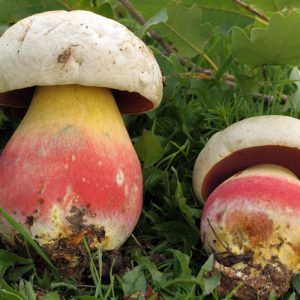










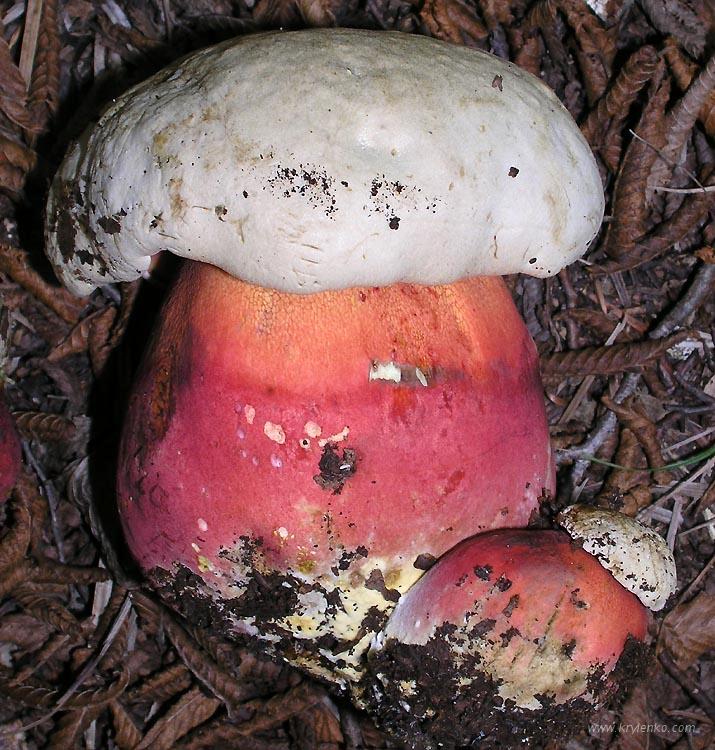

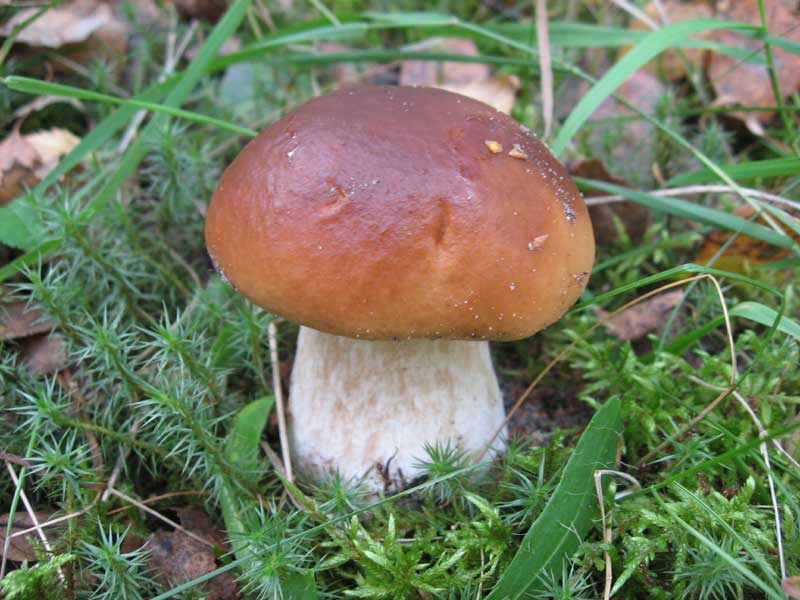
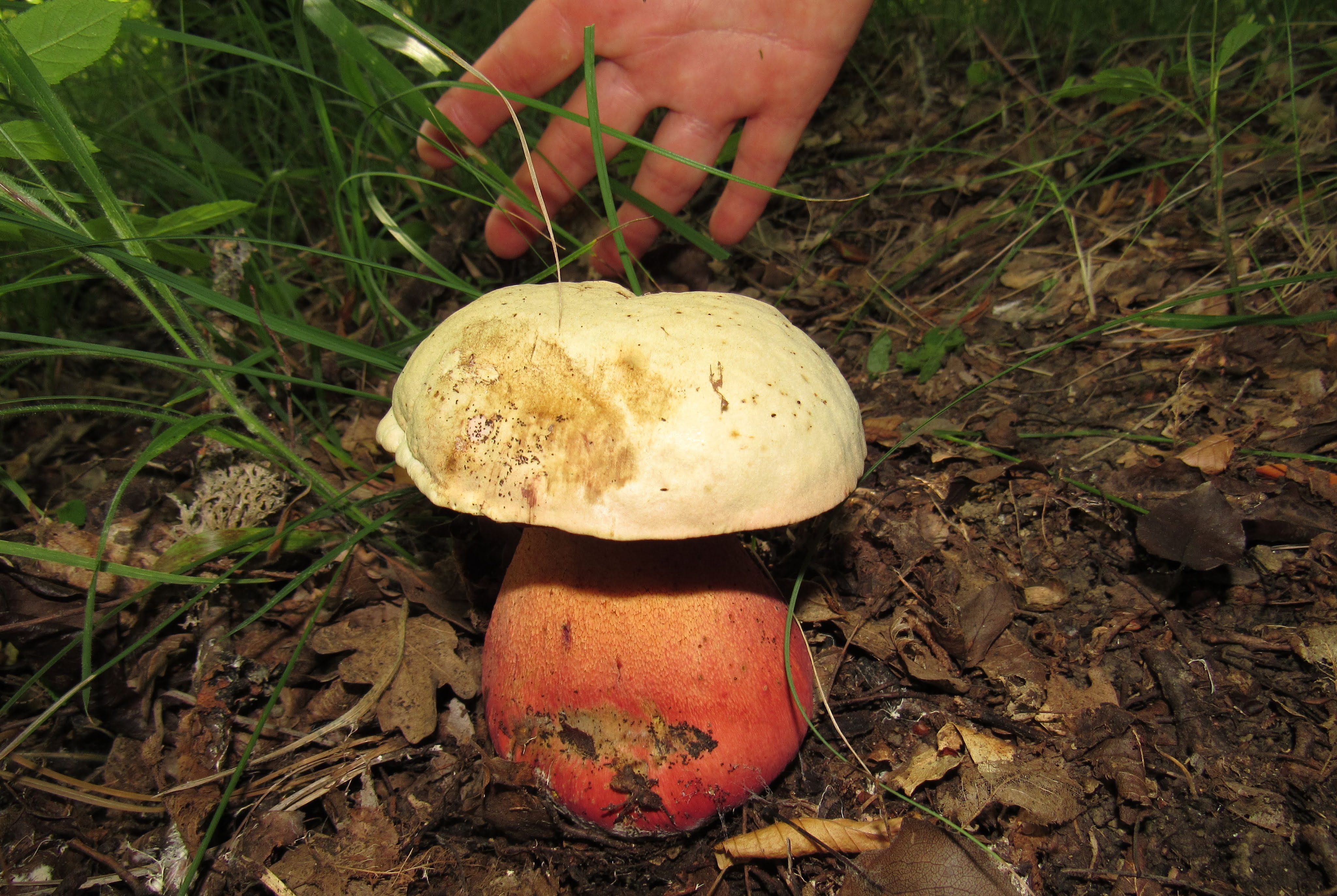
![]()



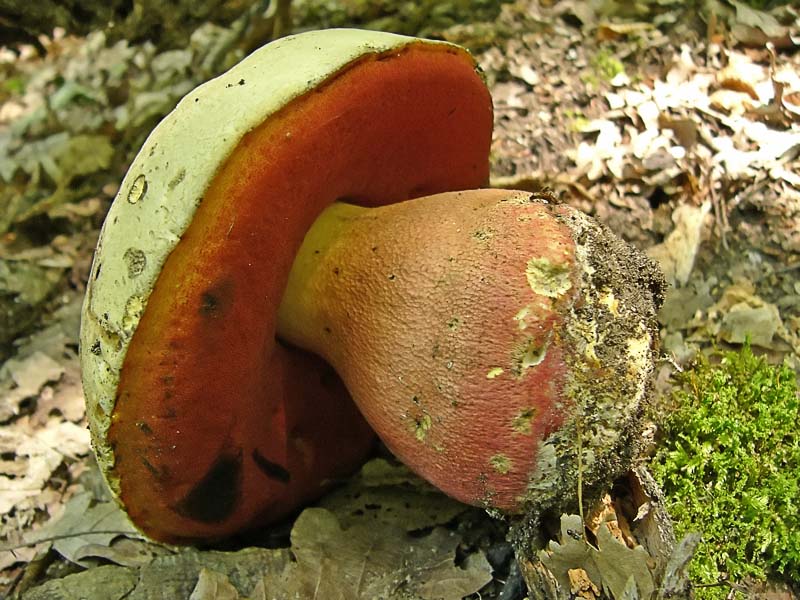

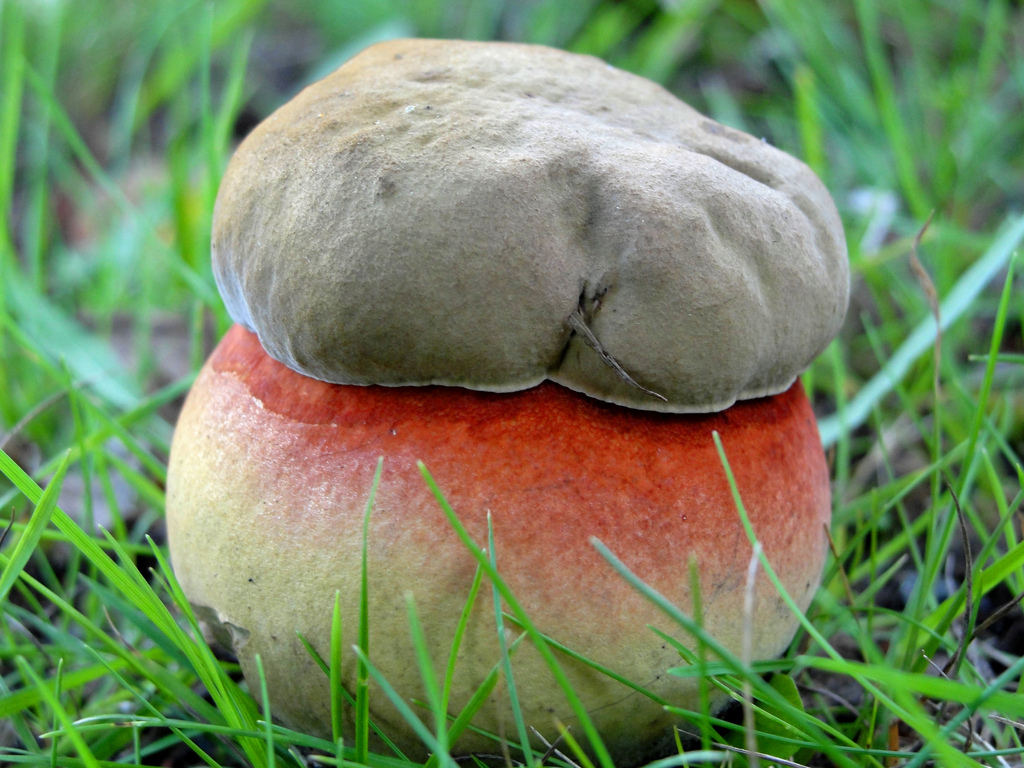


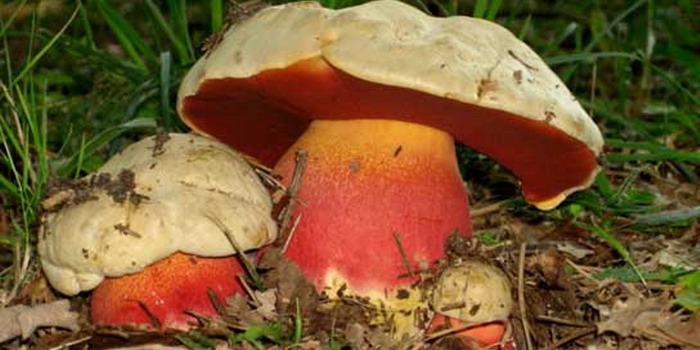
External features of the satanic mushroom (video)
Places of growth of the satanic mushroom
Grows from July to October in light deciduous forests. Most often grows under oaks and beeches, sometimes it can be found under hornbeam, linden or hazel. Prefers soil rich in limestone and warm, sunny places. It usually grows in groups of several. It can be found in Southern Europe, Morocco and the west coast of the United States. In Russia, it grows in the southern regions and in the North Caucasus. Occurs rarely.
About the edibility of the satanic mushroom
In some countries of Central Europe, lovers of culinary experiments claim that this mushroom is not only edible, but also extremely tasty. However, most mycologists question this assertion. And given that doctors, especially (apparently based on experience), resuscitators, consider it poisonous, although not fatal, then this doubt is most likely justified.
Edibility is attributed to the satanic mushroom, confusing it with any relative, because this mushroom has many doubles.

In some countries of Central Europe, lovers of culinary experiments claim that this mushroom is not only edible, but also extremely tasty.
twin mushrooms
Many lovers of "silent hunting", collecting edible and conditionally edible mushrooms, mistakenly take them for a satanic mushroom. This is not surprising, many members of the Boletov family, in addition to external similarity, turn blue (or simply change color) just like a satanic mushroom. However, it also happens vice versa - wonderful, edible mushroom take for satanic and do not take. The mushroom family is very extensive, for example, a couple of rather interesting representatives.
Dubovik olive-brown
Cap - 7-23 cm in diameter, color from yellow-orange to dirty olive, darkens when pressed, slightly sticky in high humidity, but mostly dry skin, smooth or velvety, does not separate from the pulp. The hymenophore is yellow, then olive-greenish, with red pores (therefore, the lower part of the cap has a reddish color), sometimes loses its color in old age, and turns blue when damaged. The leg has dimensions of 5-13 * 2-5 cm, yellowish or orange-yellow on top, purple in the lower part, covered with a clearly visible crimson mesh, changes color under pressure, like a hat, sometimes cylindrical thickened at the base, full inside. The flesh is pale yellow, purple at the point of articulation with the stem, pink at the base of the tubes at the break/cut site immediately becomes dark blue, and a little later blue with a reddish tint. The taste is mild, the aroma is weak, unobtrusive.

Dubovik olive-brown
Grows - from June to October in deciduous and mixed forests, in thickets of shrubs, often in parks, on clay soils rich in calcium.
Similar mushrooms - polish mushroom, Boletus erythropus (boletus) have evenly reddish leg without mesh. The satanic mushroom differs from them only in the flesh that does not turn blue at the site of damage and a whitish hat.
Attention! Although the mushroom is edible, however, when taken raw, it can cause symptoms of dyspepsia, and also exhibits poisonous properties when consumed at the same time as alcohol.
How to collect a satanic mushroom (video)
Fechtner Boletus (Boletus fechtneri)
The cap is 5-15 cm in diameter, at first semicircular, then convex, in the final phase it is flat, soft, silky fibrous. The young mushroom is whitish in color with a silvery tint, the aged mushroom is light brown. When pressed, it dims to red or brown. The tubes are very long - 15-25mm, lemon-yellow with time yellow-olive. Damaged pigeons. The pores are small, while the mushroom is young lemon-yellow, later golden-yellow and with age in olive-yellow-green tones. Turn blue when damaged. The leg is cylindrical, thick, one might say “stocky”, coarsened at the base. The color is golden yellow in the lower part with a pinkish or carmine red tint.
In older individuals, the color of red and yellow merges, and the leg becomes brown-brown. The upper part of the leg is covered with mesh. The flesh is a bright lemon-yellow color, slightly brownish under the skin of the cap, light pinkish in the stem of the stem. Damaged turns blue. The taste and smell are pleasant mushroom.
Grows - mainly under oaks and beeches in light deciduous forests. From June to August. Edible and very delicious mushroom, without any reservations.
As mentioned above, the Borovik family is very numerous and they all have a definite plus - they cannot be confused with a pale grebe.

Fechtner Boletus (Boletus fechtneri)
Satanic Mushroom and Pale Toadstool
This is due primarily to the structure of these fungi. So, for example, if in a pale grebe the hymenophore is lamellar, then in all Boletovs it is tubular. This plays a big role, especially for beginner mushroom pickers. Despite the fact that among mushrooms there are poisonous and simply inedible mushrooms, it is safer to collect them than any other, for example, russula. Poisoning with a pale toadstool is many times more dangerous than poisoning with the same satanic mushroom, although the one who eats it also faces unpleasant consequences.
Signs and consequences of poisoning
The mushroom is poisonous, especially when raw. Eating the fruiting bodies causes severe gastrointestinal disorders with severe vomiting. Muscarine has been isolated from mushrooms, but the amount found in the fruiting bodies is probably too low to be responsible for the toxic effects of consumption. satanic mushrooms. More recently, the presence of a glycoprotein has been described, which can have a toxic effect.
Considering that mistakes are possible even when collecting Boroviks, it is worth mentioning what are the symptoms of poisoning with an inedible trophy. The consequence of the use of this instance is a violation of the water and electrolyte balance and intestinal disorders. Within two hours of eating a satanic mushroom, other symptoms join the abdominal pain, including:
- nausea and severe vomiting;
- profuse, watery diarrhea;
- painful spasms in the calf muscles.
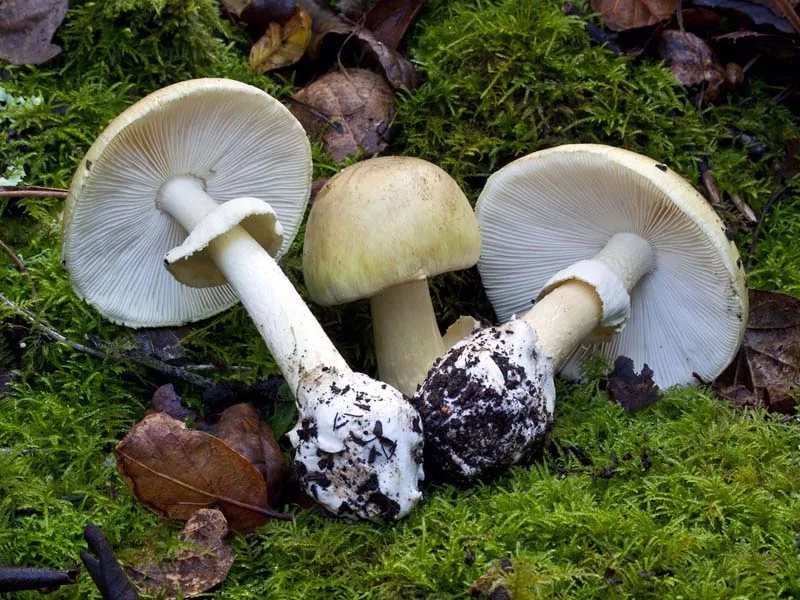
Poisoning with a pale toadstool is many times more dangerous than poisoning with the same satanic mushroom
Important! If you suspect the use of a satanic mushroom, an ambulance is required.
Three and a half hours - that's how long it will take before the first symptoms appear. Abdominal pain, nausea, vomiting, headache- the main symptoms may be accompanied by those that are not directly related to the action of fungi. These include:
- visual impairment;
- pressure drop, collapse;
- lacrimation, profuse sweating;
- redness of the face.
Mushroom toxins not only cause discomfort and intestinal disorders, but - when they affect the nervous system - also hallucinations and neurological disorders. After eating a poisonous mushroom, such as satanic, you should immediately consult a doctor. It is worth taking the remains of a dish or the remains of mushrooms, which will allow you to quickly identify the poison.
How to recognize a satanic mushroom (video)
Despite the possible troubles that can happen to mushroom lovers, “ quiet hunting» enjoys unflagging popularity. Having decided to go for mushrooms, it is important to remember a simple rule - do not take unfamiliar, questionable “trophies”.
And some secrets...
Have you ever experienced unbearable joint pain? And you know firsthand what it is:
- inability to move easily and comfortably;
- discomfort when going up and down stairs;
- unpleasant crunch, clicking not of their own free will;
- pain during or after exercise;
- inflammation in the joints and swelling;
- causeless and sometimes unbearable aching pain in the joints ... Loading...
Satanic mushroom is a conditionally edible mushroom from the genus Boletus, Boletaceae family. Acceptable names: satanic pain, Tubiporus satanas. The opinions of scientists regarding the fungus are divided. Some consider it poisonous, excluding the possibility of food consumption, others classify the mushroom as an absolutely safe product, which, if properly administered, will enrich the diet and cannot harm a person.
general characteristics
Distinctive feature conditionally edible mushroom- appearance. The hat grows from 6 to 25 centimeters in diameter. Painted in a porous white-gray or light olive shade. The hat is fleshy, dense and quite massive. It develops in the form of a semicircle with clear rounded bulges. The cap surface itself is characterized by a smooth, bare, dry texture. The texture can change depending on the weather: in slush, the surface is overgrown with a thin layer of thick slurry, and in sunlight it becomes smooth and completely dry again.
Mushroom leg dimensions: 4-15x3-6 centimeters. The stem is central, ovoid. It is by this part of the fruiting body that one can identify dangerous mushroom. It is painted a rich red (with a noticeable yellow tint) and features a pronounced mesh pattern that sticks out on the surface.
Eukaryotic flesh is dense, colored in White color. The shade of the pulp varies depending on the location: in the leg it is colored pale yellow, at the break it is red, above it it turns blue. The tubular layer of the cap also has a special variety of colors: first yellow, green, red, olive, then blue (turns blue after touching the body of the mushroom). The spore powder is colored in a pale green hue. Spore sizes are 10-16x5-7 microns. The shape of the spores is similar to an elongated elongated spindle. The structure is smooth, the shade is olive. It should be noted the fetid smell of the pulp of "old" eukaryotes, which repels not only from eating the fungus, but also from touching it. Some compare the aroma to the stench of sour foods. The “young” mushrooms have a much more pleasant taste: a light, spicy, barely perceptible mushroom plume. A noticeable contrast to the smell creates a taste of pulp.
It is strictly forbidden to taste the mushroom raw and is fraught with serious food poisoning.
The taste palette is filled with bright mushroom and barely noticeable sweetish notes.
 The representative of the boletaceae grows mainly on carbonate soil. Chooses deciduous forests (less often - mixed) in the period from June to October. Remotely, the satanic mushroom resembles the traditional white mushroom (Boletus edulis). The main difference lies in the shade of the tubular layer and the stem of the fruiting body. Mushroom pickers often do not pay attention to such a nuance and, without realizing it, they test their own body for strength.
The representative of the boletaceae grows mainly on carbonate soil. Chooses deciduous forests (less often - mixed) in the period from June to October. Remotely, the satanic mushroom resembles the traditional white mushroom (Boletus edulis). The main difference lies in the shade of the tubular layer and the stem of the fruiting body. Mushroom pickers often do not pay attention to such a nuance and, without realizing it, they test their own body for strength.
The satanic mushroom has a changeable disposition. The mesh pattern changes its color from yellow-green to pink, the hat - from white to rich marsh color. With age, even the spores change their color from honey yellow to a contrasting brown. It is necessary to know such “tricks” and be able to recognize a dangerous product in time.
Ecology and distribution
Eukaryotes do well in deciduous forests, which are fully provided with sunlight. Ultraviolet radiation is one of the main requirements of the fungus for normal development and distribution. Most often, a satanic mushroom can be found next to such trees:
- hornbeam;
- hazel;
- chestnut (exclusively edible);
- Linden.
With these trees, the boletus creates mycorrhiza (fungal root).
Mycorrhiza is a symbiotic fusion of fungal mycelium with the roots of higher plants (in our case, with the trees from the list). There are 3 types of mycorrhiza: endotrophic, ectotrophic and ectoendotrophic.
With ectopeat mycorrhiza, the hyphae of the satanic fungus braid the root of the tree with a dense network. During this fusion, a kind of cover and special mycorrhizal tubes are formed. Boletus gradually penetrates into the tree, but, at the same time, does not spread in the cells.
 In endopeat mycorrhiza, tree cells are affected by fungal hyphae. main feature: penetration occurs through the pores without touching the plasmalemma. The fungus begins to merge with the tree, develop and grow inside the root. In the cells of the tree, whole clusters of fungal hyphae begin to form. They form in the form of balls and gradually branch out within the selected tree. Such ball formations are called arbuscules.
In endopeat mycorrhiza, tree cells are affected by fungal hyphae. main feature: penetration occurs through the pores without touching the plasmalemma. The fungus begins to merge with the tree, develop and grow inside the root. In the cells of the tree, whole clusters of fungal hyphae begin to form. They form in the form of balls and gradually branch out within the selected tree. Such ball formations are called arbuscules.
With ectoendomycorrhiza, a combination of signs of two processes occurs. The fungus “settles” in the roots of the host plant and can freely move from one stage of development to another.
For successful mycorrhiza, the fungus chooses calcareous soils of Southern Europe, the southern part of European Russia, the Caucasus, the Middle East and the southern territory of Primorsky Krai.
Economic importance of mycorrhiza
Scientists have learned how to adapt natural biological processes to various areas of human existence. For example, microbiological inoculants (released during mycorrhiza) have found their way into agriculture. They help to increase the yield of many cultivated plants. Due to mycorrhiza, plants receive the maximum concentration of liquid, vitamins and useful minerals from the soil, which ultimately affects both productivity and yield. Scientists note that after mycorrhiza, the concentration especially increases.
Similar species
The list includes only species of boletus mushrooms (Boletus) with colored pores and flesh that turns blue after contact with the external environment.
Inedible mushrooms are not eaten because of the bitter taste, which is unpleasant for human receptors. Moreover, scientists say that most of them pose a danger to our body and are fraught with serious food poisoning. Inedible varieties of Boletus include:
- Boletus albidus or whitish boletus;
- Boletus calopus or inedible mushroom;
- Boletus rhodoxanthus or rose gold boletus;
- Boletus splendidus or a false variety of the satanic fungus;
- Boletus legaliae or boletus is legal (permissible name is boletus de gal).
This list also includes rare and little-studied varieties of mushrooms, the degree of safety / toxicity of which has not yet been fully studied.
 Scientists identify a number of mushrooms, opinions about which differ. Some consider them dangerous and advocate the status of toxic, others collect them in the forests themselves and would feed them with peace of mind. mushroom snack loved ones for family dinner. Conditionally edible varieties of Boletus include:
Scientists identify a number of mushrooms, opinions about which differ. Some consider them dangerous and advocate the status of toxic, others collect them in the forests themselves and would feed them with peace of mind. mushroom snack loved ones for family dinner. Conditionally edible varieties of Boletus include:
- Boletus luridus or olive-brown oak (distinguished by a tall pastel brown hat and quickly bluish flesh during contact with the environment);
- Boletus erythopus or mottled oak (distinguished by a rich dark hat, the absence of a pronounced mesh on the stem of the fruiting body and quickly turning blue flesh during contact with the environment).
Degree of eukaryotic toxicity
The issue of nutritional consumption of the satanic mushroom is still not finally resolved. But scientists nevertheless came to one unanimous opinion: in its raw form, boletus is incredibly dangerous and toxic. According to scientific research, in small piece pulp, the weight of which does not exceed 1 gram, contains a high concentration of poison. It can cause severe distress. digestive system which some patients require hospitalization.
Scientists are divided into two groups: some believe that the concentration of the poison decreases to a conditionally safe after prolonged cooking, others argue that toxins do not go anywhere and even after heat treatment they can harm a person.
Is it possible to eat a satanic mushroom in food
European countries like the Czech Republic and France have recognized the satanic boletus as conditionally edible, regulate its collection and allow their citizens to eat the desired product. But not everyone approves of such a policy. For example, the author of the book “Mushrooms” (Le grand livre des Champignons) Gerard Houdou describes Tubiporus satanas as a component hazardous to health, which leads not only to food poisoning but also death. Italian reference books also refer to the satanic mushroom as toxic food products which must not be eaten under any circumstances. Italians are of the opinion that heat treatment does not affect the degree of toxicity, therefore, a ban on the collection and use of mushrooms was introduced.
Given such an ambiguous opinion of the scientific community, it is better to refuse the use of the satanic mushroom. Even a long heat treatment for 10 hours or more cannot give absolute guarantees and provide maximum protection human body. Do not sacrifice your own health and the condition of your loved ones.
 The World Health Organization claims that 10 grams of the pulp of the satanic mushroom may well cause the death of an adult. healthy person. The cause of death lies in cardiac arrest and paralysis of the nervous system. Exposure to harmful components from eukaryotes can lead to suffocation, as the respiratory organs simply cannot function normally.
The World Health Organization claims that 10 grams of the pulp of the satanic mushroom may well cause the death of an adult. healthy person. The cause of death lies in cardiac arrest and paralysis of the nervous system. Exposure to harmful components from eukaryotes can lead to suffocation, as the respiratory organs simply cannot function normally.
Do not conduct dangerous experiments and eat only those mushrooms that are officially allowed, considered edible and absolutely safe for health. But do not lose vigilance and check the quality of the consumed product, even in supermarkets with packaged products. Check the name of the mushroom, its quality certificate, expiration date, smell and appearance. Remember that you can get poisoned not only by conditionally edible, but also common mushrooms that we see on the shelves every day.
First aid for mushroom poisoning
Signs of mushroom poisoning
The first signs of poisoning may appear more than 2 hours after ingestion. Be vigilant and do not ignore dangerous symptoms.
The first obvious symptoms are nausea and vomiting. Do not rush to turn off - this is not overeating, but rather check the pulse / temperature to make sure the cause of the ailment. After poisoning, a weak pulse and a sharp increase in body temperature are recorded in a person. After some time, a decrease in efficiency begins, a feeling of cold in the limbs, sharp pains in the abdomen.
Poisoning can provoke an exacerbation of diseases of the gastrointestinal tract, which were in remission.
Severe pain in the abdomen alternately replaced by diarrhea. In especially severe cases, a person will have to visit the toilet more than 15 times a day.
When poisoned by excessively toxic products (like a satanic mushroom), a person may develop delirium, hallucinations, and a state bordering on insanity. Moreover, a toxic fungus can cause the development of a serious disease - botulism. The disease is fraught with permanent headache, difficulty in swallowing, blurred vision, dry mouth, persistent nausea and vomiting, impaired stool and frequent convulsions.
If such symptoms appear, you should immediately consult a doctor in order to get timely help and prevent the infection from spreading throughout the body.
First aid
First aid for mushroom poisoning consists of a complex of the simplest possible manipulations. The first rule is to call the doctor. The faster you do this, the less you will have to writhe in pain and endure unpleasant changes inside your own body. There is no need to be heroic and go to the hospital on your own. It is better to observe bed rest and try to relax as much as possible until the ambulance arrives. Take a comfortable lying position, drink Activated carbon and try to consume as much healthy liquid as possible (filtered cold water, cold strong tea). If all actions are performed correctly and in a timely manner, then the competent actions of the doctor will put you on your feet the very next day.
If the fungus was excessively toxic, then the treatment can be delayed for several days and even weeks. Take care of yourself and be as careful as possible in your daily gastronomic journey.






